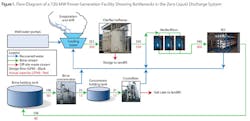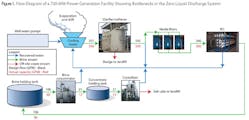By James Laughlin, WaterWorld Editor
Three papers to be presented at the upcoming International Water Conference will discuss zero liquid discharge at power generation facilities from three very different viewpoints: one examines a project just completing the design phase, another after a period of successful operation, and a third that is moving away from zero liquid discharge in favor of a simpler and lower cost option.
The International Water Conference, hosted by the Engineers' Society of Western Pennsylvania, will be held Nov. 4-8 in San Antonio, TX.
Matthias Loewenberg, GEA Process Engineering, will discuss design considerations for a ZLD system at Progress Energy's Mayo Generation Station. Marvin Drake, plant chemist for the Indiantown (FL) Cogeneration facility, will discuss the successful operation of that facility's ZLD system, and Daniel Sampson, a Senior Technical Consultant with WorleyParsons, will focus on decisions that will lead to suspension of ZLD operations at a 720 mw facility.
Progress Energy is currently installing a new partial ZLD treatment system for flue-gas desulfurization wastewater at its Mayo Generation Station in Roxboro NC. The system consists of falling film evaporator technology with a secondary forced circulation evaporator. The resulting concentrated brine will be mixed with plant fly ash and disposed in a new on-site landfill. The facility plans to recycle the distillate water for use as scrubber makeup water or boiler feed water, Loewenberg said.
"We are currently at the end of our engineering phase of this plant. The plant will go online at the end of 2013," he said. "We took actual live samples of the FGD blowdown and did a water analysis to determine the baseline of the wastewater and our own pilot evaporation tests to develop the process."
Loewenberg said consideration of a zero liquid discharge system has to be on a case-by-case basis.
"Certainly it depends on the size of the plant and therefore the blowdown stream itself," he said. "The U.S. has a variety of permitting options and each state has certain types of contaminants they focus on. Currently it involves individual customized solutions."
"Numerous treatment options were considered for this facility, however ZLD was chosen based on multi-pollutant removal ability, proven technology, and cost," he said.
Indiantown Cogeneration Facility
The Indiantown Cogeneration plant in Florida recently modified its zero liquid discharge system to incorporate the use of microfiltration and reverse osmosis to treat the blowdown from its cooling tower. The facility had been using brine concentrators, but they had begun to fail and would have required expensive upgrades. After a few initial problems, the membrane system is performing well. Filtered water is returned for use in the facility while reject water is processed through a spray drier absorber system.
Drake said the Indiantown facility had operated successfully for 15 years using the brine concentrators, but the new RO system offers significant savings. Staff expect the new system to pay for itself in three years.
Staff initially experienced problems with severe microbiological fouling that was cured with a feed of microbiocide to the RO. A second problem was scaling in the second stage of the RO. That was solved by lowering the pH of the feed water essentially to 5, Drake said.
"Cleaning a brine concentrator is expensive, time consuming and difficult," Drake said. "We had anticipated having to clean the RO monthly, but it's working out to be quarterly."
"Depending on the design of the power plant, ZLD can be an expensive and troublesome proposition, but it has managed well at Indiantown for 15 years," he said. "A great deal of thought and planning should go into the design.
"I think it's beneficial to have a dedicated staff of trained folks to operate the system. You end up with more maintenance issues than a typical non ZLD plant, but in general you will find how to make the system work for your plant. That's what we've done at Indiantown, I believe rather successfully."
Other Options
Sampson's project looks at options considered at a 720-MW power generation facility. The existing ZLD system receives cooling tower blowdown as the primary feedwater. As currently configured the single-train system consists of cold-lime softening, multimedia filtration, wastewater reverse osmosis, brine concentrator, brine crystallizer, and a belt filter press. The system performed well for the first three years of operation, but system bottlenecks restricted plant operation and required a significant amount of off-site wastewater disposal in subsequent years.
"The biggest bottleneck we have right now is the brine concentrator. It's supposed to be able to process 106 gpm of brine, but historically it can only process 60 gpm," Sampson said. "The crystallizer is the second bottleneck. It's supposed to be able to handle by design 21 gpm, but it can only handle 13 gpm. Those are the pinch points."
In looking for alternatives that would remove the bottlenecks and allow the plant to operate at full capacity, the team settled on six possible options.
"The first was is to do nothing, which had a huge operating cost associated with it," Sampson said. "They would have to haul off water they are not processing."
The second option was adding additional storage, allowing the facility to store water until the plant was operating at a lower load and had capacity to treat it. That also had a high cost. The team found that adding additional RO, media filtration and softening would have no impact on performance, while adding an additional evaporator, crystallizer and filter press would solve the problem but at a high cost.
"We then looked at two non-zero liquid discharge options: injecting the RO reject into the ground in a deep well or injecting the cooling tower blowdown directly into the ground without treatment," Sampson said. "The lowest cost was injecting the cooling tower blowdown into the ground."
As a result of the study, the facility has applied for a permit for an injection well for direct disposal of the cooling tower blowdown.
Sampson said he's found that zero liquid discharge is an option of last resort - and there are always other options.
"Zero liquid discharge is viable option if you install the necessary redundancy and capacity. But people tend to gravitate toward ZLD options without considering other alternatives, like deep well injection," he said.
"I give a lot of presentations on this subject and my advice to everyone is, 'If you have any options at all, you don't do zero liquid discharge'," Sampson said. "It really is a completely separate chemical plant on the back end of your power plant, and you end up operating your power plant trying to make the chemical plant work. It's very difficult."
Sampson said the up-front analysis of ZLD options almost never capture the actual operating costs of the plant itself. Vendors often assume the plant will run with stable chemistry and stable flow.
"In fact, power plants don't operate that way. They are up and down all the time in terms of power production. The chemistry changes, so the flow changes and that has a huge impact on how rapidly the zero liquid discharge system fouls and degrades," Sampson said.
"Most plants think they are only dealing with the capital cost component. The capital cost might be $10 million, but the O&M NPV (net present value) for a ZLD system could be north of $100 million over 30 years," Sampson said. "So, if you tell me you have zero options, I ask 'what if you had $100 million, now what are your options'?
"Nobody wants to spend that amount of money up front, but that's what they are going to spend over the life of their plant, and that opens up a whole lot of avenues for treatment that they might not otherwise think of," he said.
The conference session including the above papers is entitled, 21st Century Water Challenges: Designing and Operating ZLD Plants. It will be held Monday, November 5, from 1:30-5:00 p.m. For more information on the International Water Conference, visit http://www.eswp.com/water.



